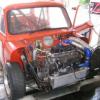New pistons are cheap enough, so no point buying second hand.
As a rule of thumb, the standard 295 head on a 998 with flattops will give 9.1:1 CR. So if you can find 28cc one way or another then you'll have a nice CR for 12psi boost.
If you go +20 (1014cc) you have 9.2:1, and +40 (1030cc) 9.3:1, still fine for 12psi.
I would advise going the the 295 route, they work very well on turbo setups. If you can't find an un-skimmed one, then you can buy flattop pistons and get a slight dish machined in them. On of my 998 turbos has 26cc chambers, so I got 2cc machned in the pistons.
I got my hands on a 12G295 head and i think it has the origional 28cc chambers. But when i tried to get the cc myself i kept getting slightly more, around 29-30cc, im assuming this is because the inlet valves seem to be sitting a bit low in the chamber, this is the only logical explanation i can get or else im getting the cc test wrong. But im hoping fitting the hardned valve seats will allow me to bring it flush again. Will the valves in it be up to the job for a turbo, as iv read somewhere that its better to fit stainless exhaust ones.Is boring it out by +20 or +40 a big advantage .i was thinking of waiting till i have the engine stripped to decide what to do and then i can see what sort of wear there is in the cyclinders and if its bad ill be boring it out anyway. But if they are good would the standard pistons i take out do with new rings.
Is 28cc the ideal chamber volume or does it depend on boost, i only reason i dont want to go mad with boost is that i want to keep it as reliable as possible. Does increasing the boost reduce reliability.
















